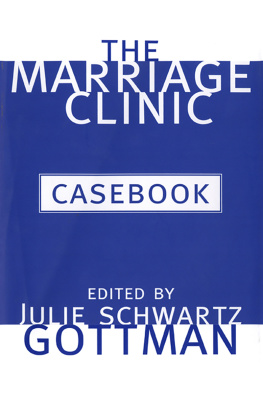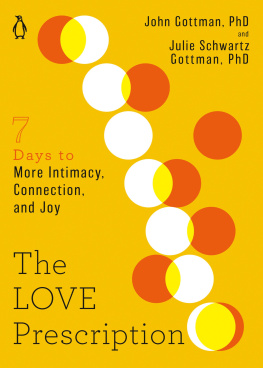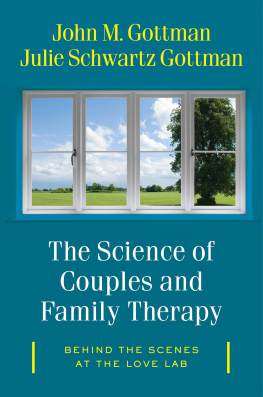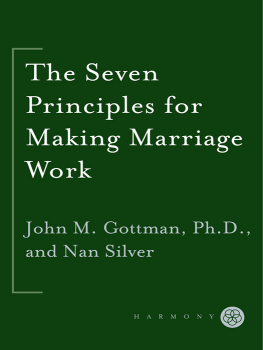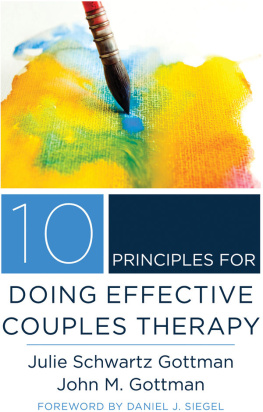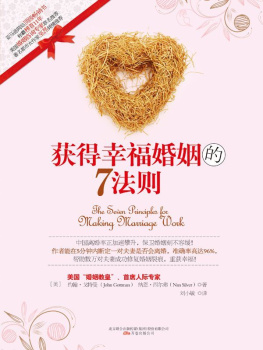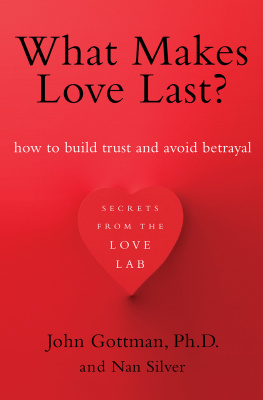
THE MARRIAGE CLINIC
CASEBOOK

Edited by
Julie Schwartz Gottman

W.W. NORTON & COMPANY
New York London
A NORTON PROFESSIONAL BOOK
The Marriage Clinic
CaseBook
The creation of this volume has been part of a journey born of a collaboration between a researcher who did some clinical work and a clinician who did some research. When Julie and I began collaborating to integrate clinical research and clinical practice, the challenge was to forge an approach that was based on genuinely respectful two-way communication. The academic orientation that I began with was arrogant and superior. If Julie told me about something that had worked with her cases, I would usually smugly ask her, Wheres your data? That attitude led to quite a lot of marital conflict. But it was also very productive. As we started working together I began learning from Julie and also learning what an amazingly talented clinician I had married. We both began to see that an integration of research and practice required mutual respect and the mutual acceptance of influence.
We began building a marriage clinic. We clinicians took years to develop trust and affection among the eighteen of us. It also took years before we could build a climate in which we could honestly talk about our treatment failures. As we did, we all started learning from one another, and the research itself broadened both in focus and in scope.
We started with a group of clinicians who came from many perspectives, from object relations to behavioral to systems, and who came from many disciplines as well. We built a clinic without walls, meaning that everyone had his or her own office but we had a central screening, referral, and triage service.
We were looking for dialogue, not a group of true believers. We were working from certain principles, theory, and data, but not from dogma. We welcomed and celebrated the work of others, both clinical, such as that of Dan Wile, and research-based, such as that of Donald Baucom, Andrew Christensen, Dan OLeary, Doug Snyder, and Susan Johnson. We also began working with same-sex relationships, based on our 12-year longitudinal study. The relationship clinic we built became an exciting base from which to work.
The marketing of our workshops led us to call our approach, which was based on the Sound Relationship House theory (Gottman, 1999), Gottman Method Couples Therapy. However, we have always felt uncomfortable with that term and the amount of ego it suggested. The approach we have developed is integrative and broad. We cite and celebrate the work of others and give credit where it is due. We see ourselves engaged in a quest for the best treatment we can devise for couples. As is characteristic of people in our field, we keep searching. We are now engaged in basic research, as well as intervention and prevention research, and have been working to extend our clinic to include national membership. The research has become more applied and the clinical work has become more experimental. We want to do research and clinical work that affects families everywhere and supplies good information based upon state-of-the-art research and practice.
The dream is for a national and international community of researchers and clinicians who will dialogue, share ideas, and network from many perspectives, so that we can offer the best service to couplesone that is based solidly on high-quality research and on high-quality practice and the collaborative interplay of the two. The real goal is understanding. This book is the first product of that collaborative interplay.
REFERENCES
Gottman, J. M. (1999). The marriage clinic: A scientifically based marital therapy. New York: Norton.
MICHAEL T. CLIFFORD, STM, M.DIV., LMFT, the Gottman Institute Relationship Clinic, Seattle, WA, and private practice, Everett, WA.
REGINA DELMASTRO, RN,C CEDC THTP, the Gottman Institute Relationship Clinic, Seattle, WA, and private practice, Bellevue, WA.
CYNTHIA H. ERVIN, PH.D., the Gottman Institute Relationship Clinic and private practice, Seattle, WA.
CONNIE FEUTZ, M.A., CMHC, the Gottman Institute Relationship Clinic, Seattle, WA, and private practice, Bellingham, WA.
JULIE SCHWARTZ GOTTMAN, PH.D., the Relationship Research Institute and the Gottman Institute, Seattle, Washington.
ANDY GREENDORFER, M.S.W., the Gottman Institute Relationship Clinic and private practice, Seattle, WA.
BARBARA JOHNSTONE, M.A., the Gottman Institute Relationship Clinic and private practice, Seattle, WA.
SARAH L. RATTRAY, PH.D., the Gottman Institute Relationship Clinic, Seattle, WA, and private practice, Shoreline, WA.
TRUDI SACKEY, M.A., LMFT, the Gottman Institute Relationship Clinic, Seattle, WA, and private practice, Kirkland, WA.
RUTH SAKS, PH.D., the Gottman Institute Relationship Clinic and private practice, Seattle, WA.
MAUREEN SAWYER, MSW, ACSW, the Gottman Institute Relationship Clinic and private practice, Seattle, WA.
TERRY STERRENBERG, M.DIV., MSW, the Gottman Institute Relationship Clinic, Seattle, WA, and private practice, Kirkland, WA.
MIRABAI WAHBE, M.A., the Gottman Institute Relationship Clinic, Seattle, WA, and private practice, Seattle and Bellingham, WA.

One summer 10 years ago, John and I sat in our canoe off the shore of Orcas Island. The sea rippled as we paused from paddling to sit and gaze into the deep forest descending to the shore.
I wonder what would happen if we created a workshop that helped couples,
John said. Weve got this beautiful data. It shows we can create change....
Wouldnt that be incredible? I replied in my usual hyperbolic style. To actually use this to really help people instead of just a few in the lab?
Wed have to build a workshop. Wed explain the theory and do exercises to lead couples through the interventions from the lab. Wed start with building friendship, forming a base for their working with conflict the next day. Only this time theyd learn different skills, the ones that work.
We both knew from Jacobsons (1984) analysis of his behavioral couple therapy outcome that one year after therapy only 33% of couples in therapy were in the nondistressed range of marital satisfaction, and that 35-50% of those couples relapsed after 2 years, leaving a dismal 17% success rate. What if we could improve on that?
We were very excited and with atypical speed paddled quickly back to shore, trudged back up the hill to our cabin, climbed up to the loft, and set to work.
A month later the manual was completed. But wed forgotten one detail: Where were the couples supposed to come from? We heard about someone who was a master program developer and between jobs. Thus Etana Dykan entered our lives, the Gottman Institute was born, and the first workshop was given in March of 1996 to 30 couples.
Meanwhile, we also created a workshop to train clinicians how to do couple therapy based on Johns research and my years with clients. It was clear that we had to have a group of advanced-level clinicians who understood our methods intimately enough to skillfully help the couples needing more than the 2-day couple workshop. We also needed their help during the couples workshops we gave, because our participant numbers were growing beyond what the two of us could easily support during the workshop exercises. In 1998, advanced trainings were offered, and from the clinicians who participated, 16 were asked to form the Marriage Clinic.
Next page
